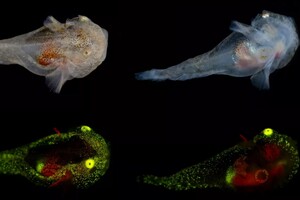Thanks to this, the fish manages not to freeze under such conditions.

Scientists drilled an iceberg off the coast of Greenland and found under him a fish in the veins of which flows green antifreeze that glows. A study by scientists has shown that juvenile mottled snailfish (Liparis gibbus) contain the “highest expression levels” of antifreeze proteins ever recorded, Live Science reports.
Similar to how antifreeze helps regulate engine temperature machines in extreme conditions, some species have developed similar defenses. This especially applies to those living in cold conditions, similar to the icy waters of Greenland.
Read also: The largest freshwater fish on Earth was discovered in Cambodia
“Antifreeze proteins stick to the surface of the smallest ice crystals and slow or prevent their transformation into larger and more dangerous crystals. Fish from both the North and South Pole independently produced these proteins,” said David Gruber, one of the authors of the study.
Antifreeze proteins were first discovered in some Antarctic fish 50 years ago. Unlike some cold-blooded species of reptiles and insects, fish cannot survive if their body fluids freeze. This can cause ice grains to form in their cells, essentially turning the fish into ice cream.
The scientists note that the fact that similar proteins have independently evolved in unrelated fish shows how important they are to survival of these creatures.
A tiny tadpole-like creature was discovered by scientists in 2019 when they were studying the diversity of water inhabitants near icebergs gathered off the coast of Greenland. Scientists were surprised by the discovery of a green and red fish-snail that glows.
“The snail was one of the few species of fish living among icebergs, in gorges. It's amazing that such a tiny fish could live in such an extremely cold environment without freezing,” Gruber said.
Arctic fish also rarely exhibit biofluorescence, the ability to convert blue light into green, red, or yellow light, because there are long periods of darkness at the poles, especially in winter. This ability is usually found in fish that live in warmer waters. This is the first known case of arctic fish exhibiting this ability.
The researchers further studied the biofluorescent properties of the snailfish and found “two different types of gene families encoding antifreeze proteins.” This adaptation helps these creatures avoid turning into frozen “fish sticks”.
Related video
High levels of antifreeze production help the fish adapt to sub-zero environmental temperatures. But this ability also raises the question of how these fish will be able to survive in a warmer ocean, the temperature of which is increasing due to global warming.




